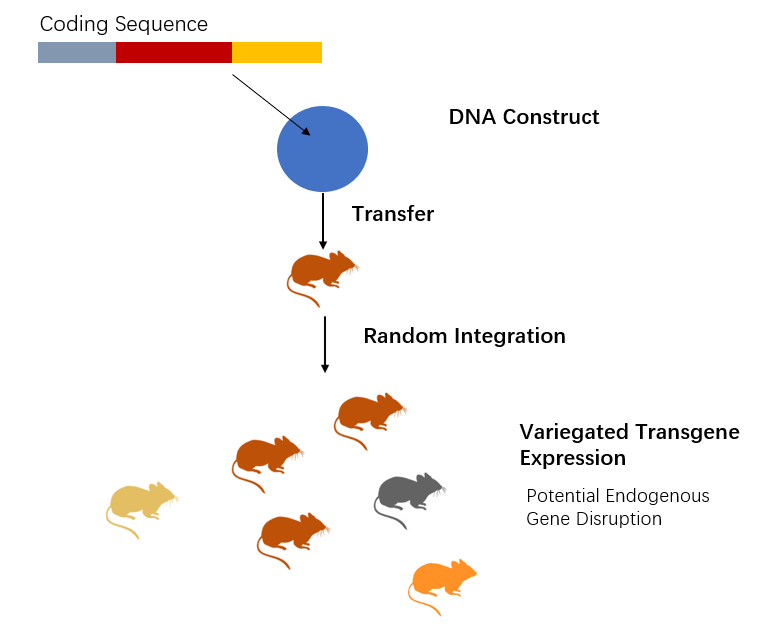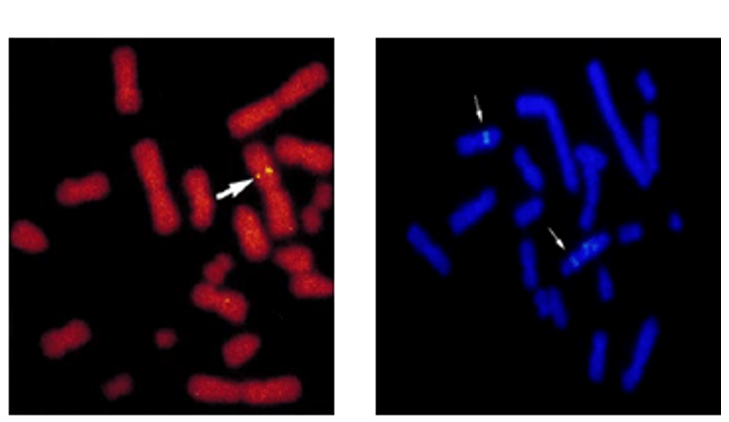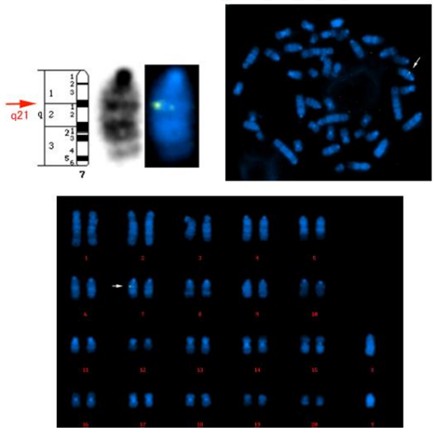- You are here: Home
- Services
- ISH/FISH Services
- Transgene Mapping (FISH)
Services
-
Cell Services
- Cell Line Authentication
- Cell Surface Marker Validation Service
-
Cell Line Testing and Assays
- Toxicology Assay
- Drug-Resistant Cell Models
- Cell Viability Assays
- Cell Proliferation Assays
- Cell Migration Assays
- Soft Agar Colony Formation Assay Service
- SRB Assay
- Cell Apoptosis Assays
- Cell Cycle Assays
- Cell Angiogenesis Assays
- DNA/RNA Extraction
- Custom Cell & Tissue Lysate Service
- Cellular Phosphorylation Assays
- Stability Testing
- Sterility Testing
- Endotoxin Detection and Removal
- Phagocytosis Assays
- Cell-Based Screening and Profiling Services
- 3D-Based Services
- Custom Cell Services
- Cell-based LNP Evaluation
-
Stem Cell Research
- iPSC Generation
- iPSC Characterization
-
iPSC Differentiation
- Neural Stem Cells Differentiation Service from iPSC
- Astrocyte Differentiation Service from iPSC
- Retinal Pigment Epithelium (RPE) Differentiation Service from iPSC
- Cardiomyocyte Differentiation Service from iPSC
- T Cell, NK Cell Differentiation Service from iPSC
- Hepatocyte Differentiation Service from iPSC
- Beta Cell Differentiation Service from iPSC
- Brain Organoid Differentiation Service from iPSC
- Cardiac Organoid Differentiation Service from iPSC
- Kidney Organoid Differentiation Service from iPSC
- GABAnergic Neuron Differentiation Service from iPSC
- Undifferentiated iPSC Detection
- iPSC Gene Editing
- iPSC Expanding Service
- MSC Services
- Stem Cell Assay Development and Screening
- Cell Immortalization
-
ISH/FISH Services
- In Situ Hybridization (ISH) & RNAscope Service
- Fluorescent In Situ Hybridization
- FISH Probe Design, Synthesis and Testing Service
-
FISH Applications
- Multicolor FISH (M-FISH) Analysis
- Chromosome Analysis of ES and iPS Cells
- RNA FISH in Plant Service
- Mouse Model and PDX Analysis (FISH)
- Cell Transplantation Analysis (FISH)
- In Situ Detection of CAR-T Cells & Oncolytic Viruses
- CAR-T/CAR-NK Target Assessment Service (ISH)
- ImmunoFISH Analysis (FISH+IHC)
- Splice Variant Analysis (FISH)
- Telomere Length Analysis (Q-FISH)
- Telomere Length Analysis (qPCR assay)
- FISH Analysis of Microorganisms
- Neoplasms FISH Analysis
- CARD-FISH for Environmental Microorganisms (FISH)
- FISH Quality Control Services
- QuantiGene Plex Assay
- Circulating Tumor Cell (CTC) FISH
- mtRNA Analysis (FISH)
- In Situ Detection of Chemokines/Cytokines
- In Situ Detection of Virus
- Transgene Mapping (FISH)
- Transgene Mapping (Locus Amplification & Sequencing)
- Stable Cell Line Genetic Stability Testing
- Genetic Stability Testing (Locus Amplification & Sequencing + ddPCR)
- Clonality Analysis Service (FISH)
- Karyotyping (G-banded) Service
- Animal Chromosome Analysis (G-banded) Service
- I-FISH Service
- AAV Biodistribution Analysis (RNA ISH)
- Molecular Karyotyping (aCGH)
- Droplet Digital PCR (ddPCR) Service
- Digital ISH Image Quantification and Statistical Analysis
- SCE (Sister Chromatid Exchange) Analysis
- Biosample Services
- Histology Services
- Exosome Research Services
- In Vitro DMPK Services
-
In Vivo DMPK Services
- Pharmacokinetic and Toxicokinetic
- PK/PD Biomarker Analysis
- Bioavailability and Bioequivalence
- Bioanalytical Package
- Metabolite Profiling and Identification
- In Vivo Toxicity Study
- Mass Balance, Excretion and Expired Air Collection
- Administration Routes and Biofluid Sampling
- Quantitative Tissue Distribution
- Target Tissue Exposure
- In Vivo Blood-Brain-Barrier Assay
- Drug Toxicity Services
Transgene Mapping (FISH)
- Overview
- Features
- Project Timeline
- Case Studies
- FAQs
For transgenic cell lines and transgenic animals generated via many methods, the integration site is random and in most cases not known. Integration of a transgene can disrupt an endogenous gene, potentially interfering with interpretation of the phenotype. In addition, knowledge of where the transgene is integrated is important for planning of crosses between animals carrying a conditional allele and a given Cre allele in case the alleles are on the same chromosome. When the transgene insertion site is unknown, zygosity is determined by expensive quantitative PCR-based approach. These limitations often force investigators to maintain transgenic models or cell lines in a hemizygous state, which may lead to less than desired expression levels of the transgene and make it less efficient and more costly. Fluorescence in situ hybridization (FISH) is a powerful technique that can be used to visualize transgene integration sites and provide a better understanding of transgene behavior.
With many years of experience and in-depth knowledge, Creative Bioarray can use fluorescence in situ hybridization (FISH) to confirm the integration of transgenes and determine their chromosome band location. We guarantee the speed, quality and cost of our service.
Benefits of Characterizing A Transgene Insertion Site
- Better correlation of phenotypes with transgene expression
- Ability to determine zygosity by genotyping assay and more cost effective management of transgenic strains
- Enhanced predictability of transgene segregation when breeding and intercrossing
- Awareness of any potential disruption of the regulatory or coding region of a critical endogenous gene
 Figure 1. Transgene integration is random.
Figure 1. Transgene integration is random.
 Figure 2. FISH detection of transgene using plasmid probes on metaphase chromosome.
Figure 2. FISH detection of transgene using plasmid probes on metaphase chromosome.
Features of Creative Bioarray's Transgene Mapping Service
- cDNA (2kb~) or genomic DNA fragment on banded chromosomes
- Species: human, mouse, rat, hamster, chicken
- Confirm the integration of transgenes
- Visualize chromosome band location
Deliverable
- Full scope support service-from sample preparation through to the final report
- Detailed report of insertion and transgene position
- Expert interpretation specific to a new transgenic line
Project Timeline

Case Studies
Transgene Mapping analysis of rat cell samples
Objective
Perform DNA FISH to confirm the integration of the transgene XXX and determine its chromosome band location in rat cell samples.
Results
Table 1: Study Sample:
| Samples | Qty |
| Rat Spleen Cells | 2 vials (5 x10^5 cells/vial) |
| Transgene XXX Plasmid | 1 vial |
The transgene was located on the q21 region of the chromosome 7.
 Figure 3. FISH detection of transgene in the rat cell sample.
Figure 3. FISH detection of transgene in the rat cell sample.
FAQs
1. What is transgene mapping?
Transgene mapping is a technique used to identify the integration sites of transgenes within the host genome. This process can provide valuable information about where genetic material has been inserted, how it may affect gene expression, and the overall genomic context.
2. Why is transgene mapping important?
Transgene mapping is crucial for understanding the functional consequences of genetic modifications. It helps researchers assess the stability of the transgene, potential impacts on neighboring genes, and overall genetic integrity. This information is essential for optimizing transgenic models for research or therapeutic applications.
3. What techniques do you use for transgene mapping?
We utilize advanced techniques such as next-generation sequencing- Transgene Mapping (Locus Amplification & Sequencing) (https://www.creative-bioarray.org/services/transgene-mapping-locus-amplification-sequencing.htm) and FISH-based methods to accurately identify transgene integration sites. Our state-of-the-art technology ensures reliable and precise results.
4. What types of samples do you accept for transgene mapping?
We accept a variety of biological samples, including frozen cells and genomic DNA extracted from transgenic organisms, tissues, or cell lines. If you have specific sample types in mind, please contact us for further information.
5. How long does the transgene mapping process take
The timeline for transgene mapping can vary based on the complexity of the project and the specific services requested. Generally, results can be expected within 4-6 weeks. We will provide a detailed timeline when you submit your project request.
6. How do I submit a sample for transgene mapping?
To submit a sample, please contact us through our website to receive detailed sample preparation and shipping instructions. Our team will guide you through the process to ensure your samples are handled properly.
Quotation and ordering
Our customer service representatives are available 24hr a day! We thank you for choosing Creative Bioarray at your preferred Transgene Mapping.
Explore Other Options
For research use only. Not for any other purpose.

